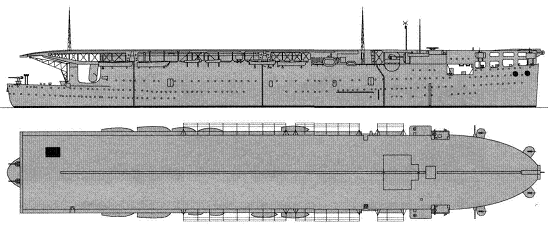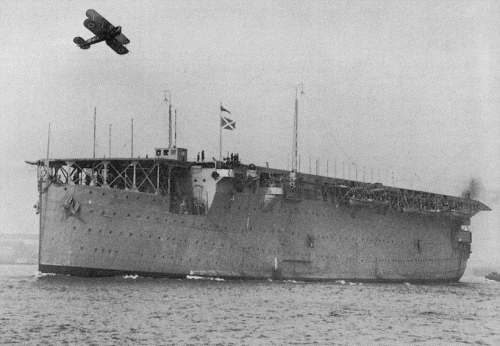
ARGUS aircraft carrier (1918)

Argus 1918

Argus 1918

Argus 1943
| Name | No | Yard No | Builder | Laid down | Launched | Comp | Fate |
| Argus (ex-Conte Rosso) | N96, 49, D49 | 611 | Beardmore, Dalmuir | 6.1914 | 2.12.1917 | 9.1918 | hulk 8.1944 |
|
Displacement normal, t |
14550 |
|
Displacement full, t |
15750 |
|
Length, m |
172.5 |
|
Breadth, m |
20.7 |
|
Draught, m |
6.4 |
|
No of shafts |
4 |
|
Machinery |
4 sets Parsons geared steam turbines, 12 cylindrical boilers |
|
Power, h. p. |
20000 |
|
Max speed, kts |
20 |
|
Fuel, t |
2000 oil |
| Endurance, nm(kts) | 7000(15) |
| Armour, mm | magazines: 51 |
|
Armament |
6 x 1 - 102/45 QF Mk V, 20 aircraft (Pup, Camel fighters, 11.2-strutter recon planes, Cuckoo torpedo bombers) |
|
Complement |
401 |
Aircraft facilities (fd - 3,571m², ha - 1,363m² / 6,135m³): Hangar: 89.7x15.2m. 2 lifts (9.1x11 and 18.3x5.5m). Aircraft fuel stowage: 63,545l. Flight deck: 143.3x22.9m.
| Year | Fighters | Torpedo bombers | Recon planes | Seaplanes |
| 1/1920 | 4 Camel | --- | 8 11.2-Strutter, 2 Walrus | 2 Fairey III |
| 1921 | --- | --- | 10 Panther | 3 Fairey IIIC |
| 7.1938 | --- | 14 Swordfish | --- | --- |
| 8.1940 | --- | 3 Swordfish | --- | --- |
| 4.1941 | --- | 12 Swordfish | --- | --- |
| 5.1941 | 3 Fulmar | --- | --- | --- |
| 8.1941 | 2 Martlet | --- | --- | --- |
| 11.1941 | 4 Fulmar, 2 Sea Hurricane | 4 Swordfish | --- | --- |
| 1.1942 | 4 Fulmar | 4 Swordfish | --- | --- |
| 10.1942 | 18 Seafire IIC | --- | --- | --- |
Project history: Argus was ordered as a passenger liner Conte Rosso by Italian shipowner. In August, 1916 she was purchased by Admiralty for conversion to aircraft carrier. The first-ever aircraft carrier with full length deck and the hangar below it. Argus originally had been equipped by two elevators, longitudinal arresting gear and had no catapults.
Protection: Underwater protection was calculated for an underwater explosion of 200kgs TNT. Magazines had 51mm-thick box-shaped protection.
Modernizations: 1922: 2 elevators were replaced by new one (6.1t)
(11/1925 - 1.1927, Chatham DYd): bulges fitted, displacement became 14555/16750t, breadth wl was 23.7m, flight deck lengthened to 167.0x23.1m; - 2 x 1 - 102/45
1932: all guns were removed.
1936: adapted for launch "Queen Bee" remote controlled flying targets.
7/1938: catapult was fitted (5.5t plane was launched at up to 120km/h), cylindrical boilers were changed by 8 Admiralty 3-drum boilers, flight deck was 167.0x25.9m, 21500hp, 19kts, 2045t of oil, 4450(16)nm, aircraft fuel stowage was 63,644l; + 2 x 1 - 102/45 QF Mk V, 3 x 4 - 12.7/62
2/1942: length of flight deck raised to 173.7m (fd - 3,596m², ha - 1,363m² / 6,135m³); + 2 x 1 - 102/45 QF Mk V, 13 x 1 - 20/70 Oerlikon Mk II/IV, 1 x 4 - 12.7/62.
1942 - 1943: - 1 x 4 - 12.7/62; + 2 x 1 - 102/45 QF Mk V
Naval service: To the beginning of the Second World War Argus was used as TS, her speed did not exceed 18.75kts. In days of war she served basically as an air transport (the maximum number of aircraft carried for once was 92). Some time after refit in 1942 Argus was used as combat ship. She was damaged by hit of 250kg bomb to aft part of flight deck 10.11.1942 in operation Torch. She was reclassified as TS after refit in September, 1943. Argus was reclassified as harbour craft in 1944.
Many thanks to Wolfgang Stöhr for additional information on this page.

Argus 1919
© Ivan Gogin, 2008-14